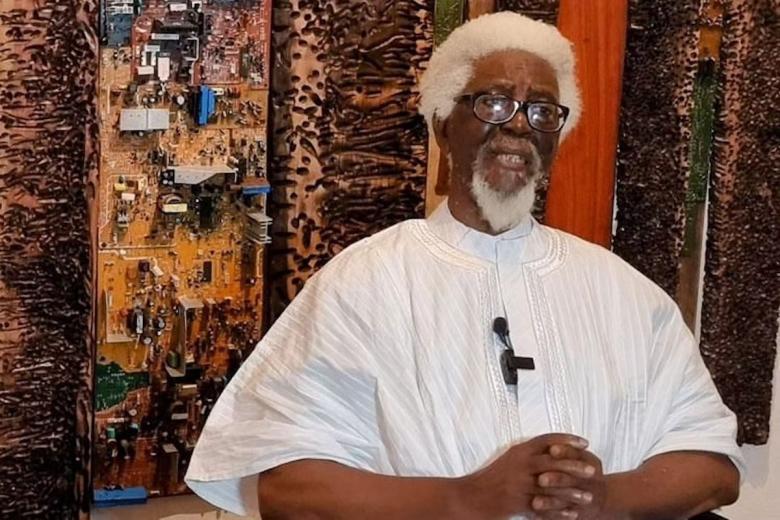Golden Lion for Lifetime Achievement to Demas Nwoko
John Hill
29. March 2023
Photo courtesy La Biennale di Venezia
Nigerian-born artist, designer and architect Demas Nwoko has been named the recipient of the Golden Lion for Lifetime Achievement by La Biennale di Venezia. He will receive the award at the inauguration of the Venice Architecture Biennale on May 20, 2023.
The selection of Demas Nwoko was made by Lesley Lokko, who is curating this year's Biennale under the theme “The Laboratory of the Future,” and was approved by the board of directors of La Biennale di Venezia, chaired by Roberto Cicutto. It is a compelling choice, one that sensibly follows from Lokko's theme (“Africa is the laboratory of the future,” she emphasizes) and her intention to “give voice to people from Africa or the African Diaspora” in the exhibition.
It is also a refreshing choice, given that Nwoko is not a familiar name: Lokko writes in her statement on the multifaceted artist–designer that his “work is still largely unknown, even at home.” Golden Lions over the last ten years have gone to famous names, from Europe (Rafael Moneo, Alvaro Siza), North America (Kenneth Frampton, Phyllis Lambert), and South America (Paulo Mendes da Rocha). This year, many visitors will be learning anew about the Golden Lion recipient — “hearing” Nwoko's voice for the first time.
Statement by Lesley Lokko:
“One of the central themes of the 18th International Architecture Exhibition is an approach to architecture as an ‘expanded’ field of endeavours, encompassing both the material and immaterial worlds; a space in which ideas are as important as artefacts, particularly in the service of what is yet to come. With all of its emphasis on the future, however, it seems entirely fitting that the Golden Lion for Lifetime Achievement should be awarded to someone whose material works span the past 70 years, but whose immaterial legacy — approach, ideas, ethos — is still in the process of being evaluated, understood and celebrated.
“Baba (a Nigerian honorific title) Demas Nwoko is everything all at once: an architect, sculptor, designer, writer, set designer, critic, and historian. When pushed, he refers to himself as an ‘artist-designer,’ which speaks both to the polyglot nature of his talents and oeuvres, and to the rather narrow interpretation of the word ‘architect’ that has arguably kept his name out of the annals.
“The son of a traditional Obi (ruler), he was born in 1935 in Idumuje-Ugboko, southern Nigeria. His early forays into painting, drawing, and carving at secondary school in Benin City pushed him to apply for a place to study architecture at the Nigerian College of Arts, Science and Technology in Zaria. However, his discovery that the course focused more on technical drawing skills than the creative imagination prompted him to change tack, applying instead to study fine art. He was a founder member of the Zaria Art Society – a group that included Yusuf Grillo, Bruce Onobrakpeya, Uche Okeke and Simon Okeke, also known as the ‘Zaria Rebels’ — who were interested in a blend of modernity and African aesthetics as an authentic language to reflect the spirit of political independence growing in the 1940s and 1950s.
“This profound desire to blend and synthesize, rather than sweep away, has characterized Nwoko's work for over five decades. He was one of the first Nigerian makers of space and form to critique Nigeria’s reliance on the West for imported materials and goods, as well as ideas, and has remained committed to using local resources.
“Although relatively few, Nwoko’s buildings in Nigeria fulfill two critical roles. They are forerunners of the sustainable, resource-mindful, and culturally authentic forms of expression now sweeping across the African continent — and the globe — and they point towards the future, no mean achievement for someone whose work is still largely unknown, even at home. In 1977, writing about Nwoko’s first commission, to build the complex for the Dominican Institute in Ibadan, the architectural critic Noel Moffett wrote: ‘Here, under a tropical sun, architecture and sculpture combine in a way which only Gaudí perhaps, among architects, has been able to do so convincingly.’
“It gives me enormous pride and pleasure to award the Golden Lion for Lifetime Achievement to Demas Nwoko, an architect of both the 20th and 21st centuries, and to encourage all visitors to the 18th International Architecture Exhibition to visit the small but perfectly formed and articulated display of his work in the Stirling Pavilion in the Giardini, alongside the Book Pavilion Project of The Laboratory of the Future."
[Source]
